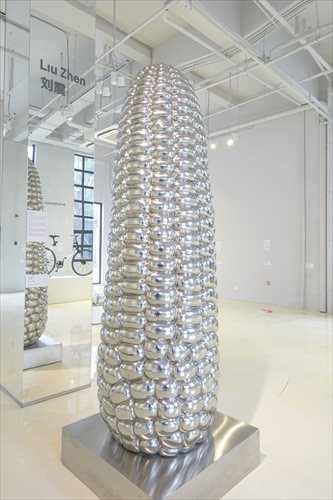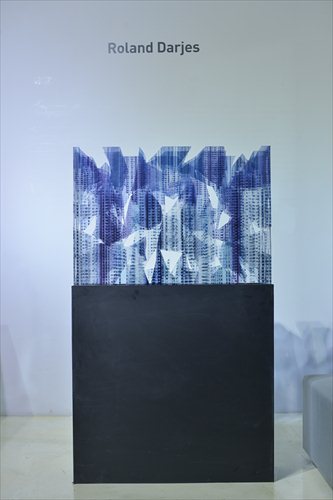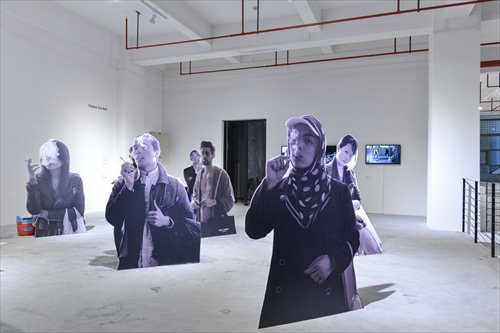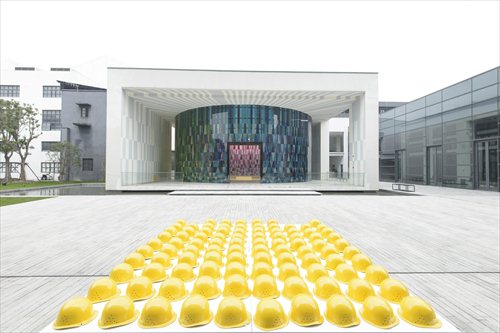Artists look into the urban renewal process in Shanghai
Exhibition looks into the urban renewal process in Shanghai
Zane Mellupe, an artist from Latvia, has been living in China for over 10 years. Four years ago she wished to change Yongkang Road into an art street, and set up seven spaces. However, the area soon became packed with bars and restaurants, pushing up rents on the street.
This sparked Mellupe's interest in urban change, and led her to curate new exhibition Babel Me, which approaches the topic of urban renewal and how it affects society on multiple levels.
"I see how people react to what's happening on Yongkang Road. Some are happy because the bars can pay the rents, some people are not so happy because they make too much noise. These urban changes made me very interested," Mellupe told the Global Times.
Repurposed structures
The exhibition is being held at Shanghai Museum of Glass, an urban project itself - it used to be a glass instrument factory.
Mellupe said the name of the exhibition came from the legend of the Tower of Babel.
"We keep building up and building ourselves and building our demands. I think it is great to expand as a person and also to shrink as a person. You can have a house for yourself, but you can also get rid of everything," said Mellupe.

Big Corn by artist Liu Zhen
The rapid growth of the city is reflected in Chinese artist Liu Zhen's work Big Corn, which is on display at the exhibition. In this piece, Liu expresses feelings about architecture in modern cityscapes. It consists of a stainless steel sculpture resembling a cob of corn more than two meters high. The kernels are welded one by one, and polished to give a mirror effect. They represent the artist's anxiety about urban architecture.
"Liu Zhen's piece exaggerates the speed of growth and poses questions like 'who is the biggest?' and 'who is the largest?' like there is a certain competition," said Mellupe.
Indecent exposure
With the piece Shanghai Slow Fast, French art group *LLND connects tradition with rapid change by juxtaposing animal-headed taichi practitioners with famed high-rises in Shanghai. Mellupe said the piece highlights the alienation the city can cause.

Break the City by artist Roland Darjes
German artist Roland Darjes's mixed media installation Break the City explores how living in high-rise blocks can affect our lives. Darjes came to China eight years ago. He is constantly gathering impressions from the streets, which he presents through his art.
Break the City is a model of high-rise blocks made from transparent blocks. The transparency represents the lack of privacy between neighbors.
"People live so close to each other that you can literally look inside other's lives. It's like we are exposed to each other," said Mellupe.
Some parts of the blocks are broken and the pieces are missing to represent the broken city and community.
"People keep on changing. It keeps going back and forth," said Mellupe.

Blasé by artist Hadas Zucker
In Blasé, artist Hadas Zucker asked friends and colleagues to pose with handbags and cigarettes. She photographed them and put the images on billboards. On the other side of the billboards, Zucker put commercial products like cigarettes and alcohol.
"It's about young people who are moving from one city to another city and from one country to another. As the world is getting so international, things are getting so much the same," said the curator.

24 Hour Sunshine by artist collective LogArtOn Photos: Courtesy of Daniele Mattioli
For the workers
Ceramics work 24 Hour Sunshine pays tribute to the workers behind the physical changes of the city's built environment. The piece by art collective LogArtOn consists of 100 yellow safety helmets made from ceramics.
Wang Fang, a member of the collective, said the piece was inspired by her experience as an architect on Chinese construction sites over the past decade.
"I see them working from winter to summer in poor weather. I see their involvement in how the city is built up, transformed and regenerated. If we talk about the condition of the workers, there are quite a lot of negatives, but we want be positive. So we gave this piece a very positive name," Wang told the Global Times.
Having lived and studied in Germany, Wang has seen differences between Germany and China in terms of urban renewal projects.
"In Germany, they preserve not only the buildings themselves but also the local economies and social structures, which is really important. In China's urban renewal, we move people out. We preserve the building as a museum or restaurant. The function of it is totally changed. The social economic area is totally changed, while in Europe you still see the old city living," said Wang.
This could be the topic of Mellupe's next exhibition. She plans to put on six exhibitions over the next year.
"There will probably be more because this is a topic with so many different aspects," said Mellupe.
Date: until March 18, 9:30 am to 5 pm (closed Mondays)
Venue: Shanghai Museum of Glass
Address: 685 Changjiang Road West 长江西路685号
Admission: Free
Call 6618-1970 for more information
Newspaper headline: Charting changes